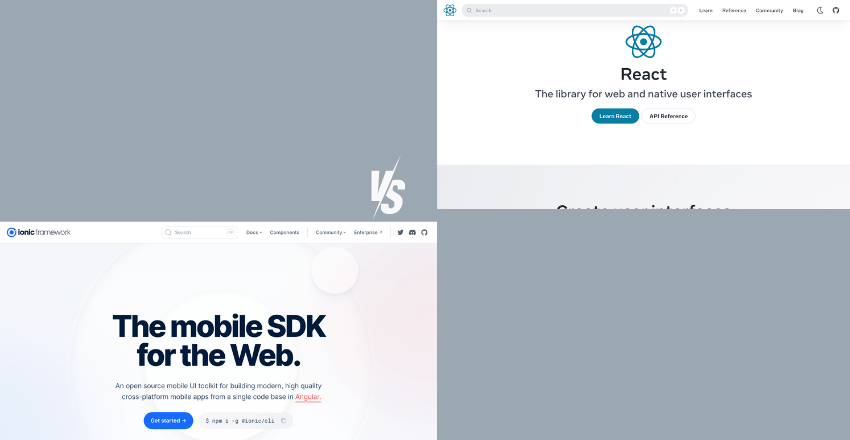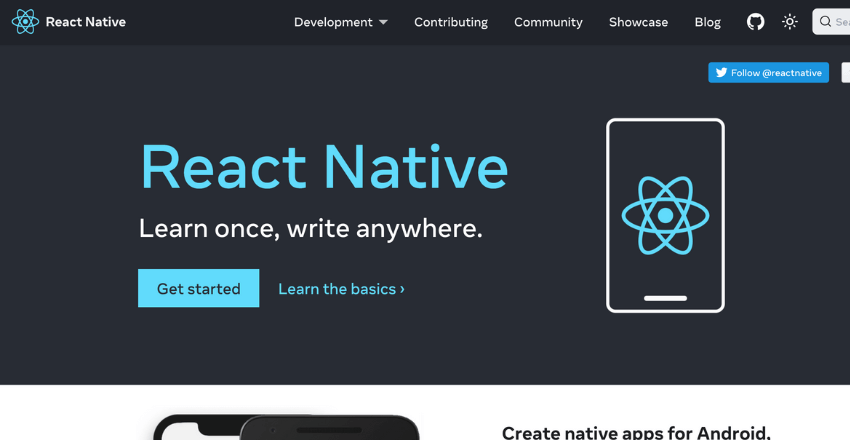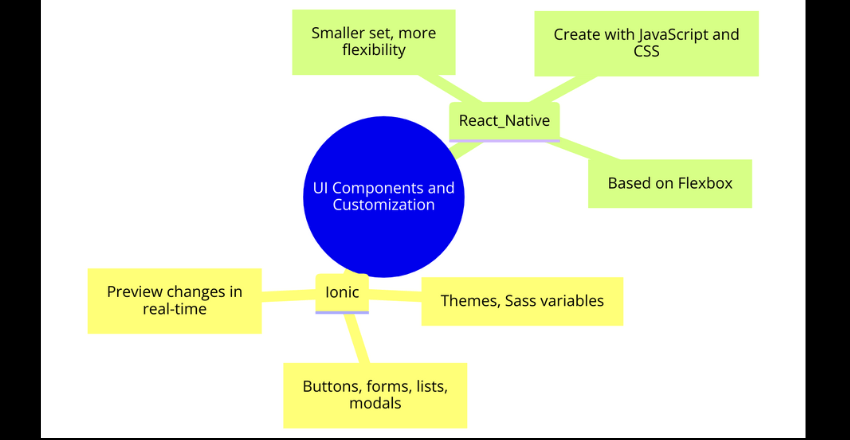
Ionic vs React Native: Dive into the heart of cross-platform development, examining ease of use, community support, and integration capabilities.
Choosing the right framework for cross-platform mobile app development can be a daunting task, especially with the sheer number of options available. Two of the most popular frameworks for developing multi-platform mobile apps are Ionic and React Native.
Each framework offers its own set of advantages and disadvantages, making it crucial to evaluate them in terms of usability, performance, platform versatility, and other important factors.

Ionic and React Native
Mobile app development is becoming increasingly essential for businesses of all sizes, and choosing the right framework is critical to success. Two popular frameworks for cross-platform app development are Ionic and React Native. In this section, we will provide an overview of both frameworks, compare their features, and evaluate their capabilities for mobile app development.
Ionic

Ionic is an open-source framework that allows developers to use web development technologies such as HTML, CSS, and JavaScript to build mobile apps for iOS, Android, and the web. It is known for its ease of use, speed, and flexibility, making it a popular choice for beginners and experienced developers alike. Ionic offers a vast library of pre-built UI components, which can be customized according to the app’s requirements.
React Native

React Native is another popular open-source framework for building cross-platform mobile apps using JavaScript. It allows developers to build native apps for iOS, Android, and the web using a single codebase, making it an efficient and cost-effective option for businesses. React Native offers pre-built UI components that can be used to develop efficient and responsive mobile apps.
Both Ionic and React Native have their strengths and weaknesses when it comes to mobile app development. In the following sections, we will compare the two frameworks based on their usability, performance, platform versatility, user interface components, native device access, community and ecosystem, development speed and maintenance efficiency, scalability and performance optimization, and pros and cons.
Usability and Learning Curve
In terms of usability and the learning curve required, Ionic and React Native have both strengths and weaknesses.
Ionic is easier to learn for developers with a background in web technologies such as HTML, CSS and JavaScript. The framework is built with web technologies, which makes it more familiar to web developers, and therefore, quicker to learn. Ionic also has an extensive documentation and a large community of developers, which makes it easier for developers to find solutions to any issues they may encounter.
On the other hand, React Native has a steeper learning curve but offers more flexibility. Developers need to have a good understanding of JavaScript to work with React Native. The framework is built with a different architecture and uses a different syntax than web technologies, which might take some time for web developers to adapt. However, the advantage of React Native is that it provides a more native experience and better performance for mobile apps.
Therefore, the choice between the two frameworks depends on the specific project requirements and the developer background. Ionic may be a better choice for a project that requires a quicker development process and a more web-like experience.
React Native may be a better choice for a project that requires a more native experience and better performance.
Performance and Speed

When it comes to mobile app development, performance and speed are critical factors that can impact user experience. In this section, we will compare the performance and speed of apps built with Ionic and React Native, two popular cross-platform frameworks.
Note: The following performance metrics are based on the latest available data at the time of writing and may be subject to change over time.
Rendering Speed
React Native has a reputation for providing fast rendering speeds due to its underlying architecture. It uses a native approach to rendering, which means that app components are compiled into native code before runtime. This results in smooth and quick rendering times, even for complex animations and transitions.
On the other hand, Ionic uses web-based technologies such as HTML, CSS, and JavaScript to build apps. This means that rendering is not as fast as React Native, but it’s still relatively quick considering the web-based approach. However, complex animations and transitions may not be as smooth as those in React Native.
App Responsiveness
Both frameworks offer high app responsiveness, with quick response times to user interactions. React Native’s use of a native rendering approach provides faster response times compared to Ionic, which relies on web technologies. However, both frameworks offer sufficient app responsiveness for most use cases.
Memory Usage
Memory usage is an essential factor that can impact the overall performance of mobile apps. React Native utilizes a smaller memory footprint compared to Ionic, mainly because it compiles into native code. The reduced memory usage leads to smoother app performance and faster load times.
On the other hand, Ionic uses Angular, a larger and more complex framework that requires more memory to run. However, Ionic has an advantage in terms of cross-platform compatibility since it runs on web technologies, which means it can run on platforms that React Native may not support.
Overall Performance and Speed
Overall, React Native has a reputation for providing better performance and speed compared to Ionic. However, this advantage is partially offset by Ionic’s cross-platform compatibility and its ability to run on platforms that React Native does not support. Choosing between the two frameworks ultimately depends on specific project requirements and priorities.

Platform Versatility
When it comes to cross-platform development, both Ionic and React Native offer choices for mobile app developers. However, there are some key differences in their platform versatility.
Ionic is known for its ability to create web, Android, and iOS apps with a single codebase. It provides multiple UI components and pre-built themes for creating consistent user interfaces across different platforms. However, it may require additional plugins for accessing native device features.
React Native, on the other hand, allows developers to build apps for multiple platforms, including Android, iOS, Windows, and the web. Its platform-specific modules and built-in components offer more direct access to native device functionalities, resulting in faster app performance. However, it may require additional development time for ensuring consistency in UI design across different platforms.
| Framework | Platform Support |
|---|---|
| Ionic | Web, Android, iOS |
| React Native | Android, iOS, Windows, Web |
Overall, both Ionic and React Native provide options for developing cross-platform apps. It’s important to consider the specific needs of your app and its target audience when choosing a platform.
User Interface (UI) Components and Customization

One of the key aspects of mobile app development is the user interface (UI), and Ionic and React Native both offer UI components for developers to create visually appealing and functional interfaces. However, there are differences in how these frameworks handle UI development and customization.
UI Components
Ionic offers a wide range of pre-built UI components, including buttons, forms, lists, and modals. These components are customizable and can be easily styled to match the app’s overall design. React Native, on the other hand, provides a smaller set of built-in UI components. While this may seem like a disadvantage, React Native makes up for it by providing more flexibility in customizing these components.
React Native also allows developers to create their own UI components using JavaScript and CSS, which can be shared across multiple projects. This approach can be more time-consuming initially, but it can lead to more consistent UI elements and faster development in the long run.
Customization
Ionic provides a variety of tools for customizing the look and feel of UI components, including pre-built themes and Sass variables. The framework also offers a live reload feature for previewing changes in real-time, making it easier to experiment with different styles. However, customizing Ionic components may require more CSS knowledge.
In contrast, React Native’s styling system is based on Flexbox, a widely-used layout system that many web developers are already familiar with. This can make it easier for developers to customize UI components and layout, although there may be a steeper learning curve for those who are new to Flexbox.
Both Ionic and React Native provide UI components for creating mobile app interfaces, but they approach customization in different ways. Ionic offers more built-in components and tools for customization, while React Native provides more flexibility in creating custom components and styling with a popular layout system.
Native Device Access and APIs
When it comes to accessing native device features and APIs, both Ionic and React Native have different approaches. React Native provides more direct access to native device features while Ionic relies on plugins that act as a bridge between the app and the device. However, both frameworks provide a comprehensive set of APIs for developers to work with.
React Native has an advantage when it comes to accessing native device features as it provides direct access to both Android and iOS APIs. This allows developers to make use of the device’s hardware features such as the camera, GPS, and Bluetooth with ease. On the other hand, Ionic relies on third-party plugins to bridge the gap between the app and the device. While this approach can lead to some limitations, it provides more flexibility and control over the feature’s usage.
When it comes to plugin support and integration, both frameworks have a strong community that provides support in the form of plugins. React Native has a larger number of plugins available, making it easier for developers to integrate new features into their app. However, Ionic’s plugins are known for their stability and ease of use. This makes it easier for developers to implement new features without worrying about compatibility issues.
| Ionic | React Native | |
|---|---|---|
| Access to native device features | Relies on third-party plugins | Direct access to Android and iOS APIs |
| Plugin support and integration | Known for stability and ease of use | Larger number of plugins available |
While both frameworks provide a comprehensive set of APIs for accessing native device features, React Native has an advantage when it comes to direct access to the device’s hardware. However, this comes at the cost of plugin support and integration which is where Ionic excels. Ultimately, the choice between the two frameworks will depend on the project’s specific needs and priorities.
Community and Ecosystem

When choosing a cross-platform development framework, it’s important to consider the support and resources provided by the community and ecosystem surrounding the framework. Both Ionic and React Native have active and engaged communities, but there are some key differences to note.
The React Native community is larger, with a larger number of contributors and more online resources available. This can make it easier to find answers to development questions and to access helpful libraries and plugins. However, the community can be fragmented, with different groups focusing on specific aspects of the framework.
The Ionic community is smaller but more tightly-knit, with a focus on building hybrid mobile and web apps. The framework is well-documented, and there are several helpful online resources available, including forums and tutorials. Additionally, the ecosystem surrounding Ionic is expanding, with new plugins and libraries being developed regularly.
Both frameworks have strong support from third-party libraries and plugins, which can help developers build apps more efficiently. However, because React Native is a more widely used framework, it tends to have more resources available in this regard.
Development Speed and Maintenance Efficiency
When comparing Ionic and React Native, development speed and maintenance efficiency are important considerations for businesses looking to create cross-platform apps.
Both frameworks have their own advantages and disadvantages when it comes to development speed. Ionic, being built on Angular, has a steeper learning curve, but once developers are familiar with the framework, they can develop apps at a faster pace. On the other hand, React Native has a lower learning curve, allowing developers to start building apps faster, but its debugging process can be time-consuming.
In terms of maintenance efficiency, Ionic’s component-based architecture and code reusability make it easier to maintain and update apps. It also has built-in tools for testing and debugging, which can help reduce development time. However, React Native’s Hot Reloading feature allows developers to see code changes in real-time, reducing the time needed for testing and maintenance.
Ultimately, the choice between Ionic and React Native comes down to the specific needs of the project and the skillset of the development team. Both frameworks have their own strengths in terms of development speed and maintenance efficiency, and it’s important to evaluate these factors carefully before making a decision.

Scalability and Performance Optimization
When it comes to developing cross-platform apps, scalability and performance optimization are critical factors to consider. Here, we will compare the capabilities of Ionic and React Native in this regard.
Scalability
Both Ionic and React Native have proven to be scalable frameworks for app development. They offer various tools and techniques to handle complex applications with large data sets and high user loads.
For Ionic, the use of web technologies like HTML, CSS, and JavaScript allows for easy scalability since these technologies are inherently scalable. Ionic also offers features like lazy loading, which allows developers to load modules only when needed, improving application performance and scalability.
On the other hand, React Native uses a modular architecture, which allows for easy scaling and code reuse. Developers can easily break down the app into reusable components, making it easier to manage and update.
Performance Optimization
Performance optimization is crucial for creating apps that deliver a seamless user experience. Both Ionic and React Native offer various techniques and tools to optimize app performance.
Ionic offers features like AOT (Ahead of Time) compilation, which compiles the app in the browser before running it on the device, resulting in faster loading times. Ionic also provides developers with tools like Performance Profiler, which gives developers insights into how their app is performing and where they can optimize it.
React Native, on the other hand, offers features like Hot Reloading, which allows developers to see changes instantly without having to rebuild the entire app, resulting in faster development times. React Native also provides tools like the Performance Monitor, which helps developers identify performance bottlenecks and optimize their apps accordingly.
Overall, both Ionic and React Native offer scalable and performant frameworks for cross-platform app development. Developers can choose the one that best suits their needs based on their specific project requirements.
Pros and Cons

After analyzing the features and capabilities of both Ionic and React Native, it is clear that each framework has its strengths and weaknesses. Here is a summary of the pros and cons:
| Ionic | React Native | |
|---|---|---|
| Pros |
|
|
| Cons |
|
|
Ultimately, the choice between Ionic and React Native will depend on the specific needs and goals of the project. For simple apps with limited functionality, Ionic may be the best option for quick and easy development. However, for more complex apps with high-performance requirements and a need for access to native APIs and device features, React Native may be the better choice.
Wrapping up

Both Ionic and React Native are powerful frameworks for mobile app development. When choosing between the two, it is important to consider factors such as usability, performance, platform versatility, UI components, native device access, community support, development speed, maintenance efficiency, scalability, and performance optimization.
While Ionic may have an advantage in terms of cross-platform compatibility and ease of use, React Native’s performance and native mobile app development capabilities cannot be ignored. Ultimately, the choice between the two will depend on the specific needs and goals of each individual project.
Therefore, it is recommended that businesses consult with experienced cross-platform app developers, like those at Hire Cross Platform, to determine which framework is the best fit for their mobile app development needs. Choose the right framework and take the first step towards building a successful mobile app for your business.
About Hire Cross Platform
Hire Cross Platform is a leading mobile app development company that specializes in cross-platform app development. Our team of expert cross-platform app developers from South America has years of experience in creating mobile apps that work seamlessly across multiple platforms, including iOS, Android, and the web.
At Hire Cross Platform, we understand the importance of delivering high-quality, reliable, and scalable mobile apps that meet our clients’ needs. We offer a wide range of mobile app development services, from design and development to maintenance and support.
Our cross-platform app developers are skilled in using various technologies and frameworks, including Ionic and React Native, to develop robust and scalable mobile apps. We work closely with our clients to understand their unique requirements and deliver customized mobile app solutions that meet their business goals.
Whether you are a startup or an established enterprise, you can count on Hire Cross Platform to provide you with the best mobile app development services. Contact us today to learn more about how we can help you bring your mobile app idea to life.
External Resources
FAQ

1. What are the main differences in performance between Ionic and React Native?
Answer:
React Native generally offers better performance than Ionic because it uses native components, allowing for smoother animations and transitions. Ionic, on the other hand, relies on web technologies and runs inside a WebView, which can lead to slightly slower performance on complex or graphics-intensive applications.
Code Sample React Native:
import React from 'react';
import {Text, View} from 'react-native';
const HelloWorldApp = () => {
return (
<View style={{flex: 1, justifyContent: 'center', alignItems: 'center'}}>
<Text>Hello, world!</Text>
</View>
);
}export default HelloWorldApp;
Code Sample Ionic:
<ion-app>
<ion-header>
<ion-toolbar>
<ion-title>
Hello World
</ion-title>
</ion-toolbar>
</ion-header>
<ion-content class="ion-padding">
Hello, world!
</ion-content>
</ion-app>Explanation:
The React Native example renders a simple view using native components, leading to a performance akin to a native application. The Ionic example uses standard web technologies that are rendered inside a WebView, making it slightly less performant than its React Native counterpart, especially on complex UIs or animations.
2. How does the development experience differ between Ionic and React Native?
Answer:
The development experience in React Native is more focused on a native approach, requiring knowledge of native development concepts. Ionic offers a more web-centric development experience, using familiar web technologies like HTML, CSS, and JavaScript, making it potentially more accessible to web developers.
Explanation:
React Native developers often need to bridge native code with JavaScript for more complex functionalities, which can steepen the learning curve for developers without a background in native mobile development. Ionic’s use of web technologies can make the transition from web to mobile development smoother but might limit performance and native feel for more intensive applications.
3. How do Ionic and React Native handle UI components and styling?
Answer:
React Native provides a set of UI components that are mapped to their native equivalents, allowing for a more native app feel. Ionic uses web components for its UI, which are styled to mimic native elements but are rendered within a WebView.
Code Sample React Native (Styling):
import {StyleSheet, Text, View} from 'react-native';
const styles = StyleSheet.create({
container: {
flex: 1,
justifyContent: 'center',
alignItems: 'center',
backgroundColor: '#F5FCFF',
},
text: {
fontSize: 20,
textAlign: 'center',
margin: 10,
},
});Code Sample Ionic (Styling):
/* Global styles */
ion-content {
--background: #F5FCFF;
}
.custom-text {
font-size: 20px;
text-align: center;
margin: 10px;
}Explanation:
React Native’s approach to styling is closer to traditional React, using JavaScript objects to style components, which can then be directly applied to native elements. Ionic, however, allows developers to use standard CSS to style components, which can be more familiar to web developers.
Both approaches offer a comprehensive system for styling, but React Native’s method is more aligned with native development, while Ionic’s approach is more akin to web development.

Charlotte Williams is a talented technical author specializing in cross-platform app development. With a diverse professional background, she has gained valuable experience at renowned companies such as Alibaba and Accenture. Charlotte’s journey in the tech industry began as a mobile UX designer back in 2007, allowing her to develop a keen understanding of user-centric app design.
Proficient in utilizing frameworks like React Native and Flutter, Charlotte excels in building cross-platform mobile apps and imparting her knowledge to aspiring developers. She pursued a degree in Computer Science at Cornell University, equipping her with a strong foundation in the field. Residing in San Francisco with her three beloved dogs, she finds solace in hiking the hills and connecting with nature. Charlotte’s passion for app development, combined with her dedication to sharing expertise, makes her an invaluable resource in the world of cross-platform app development.






